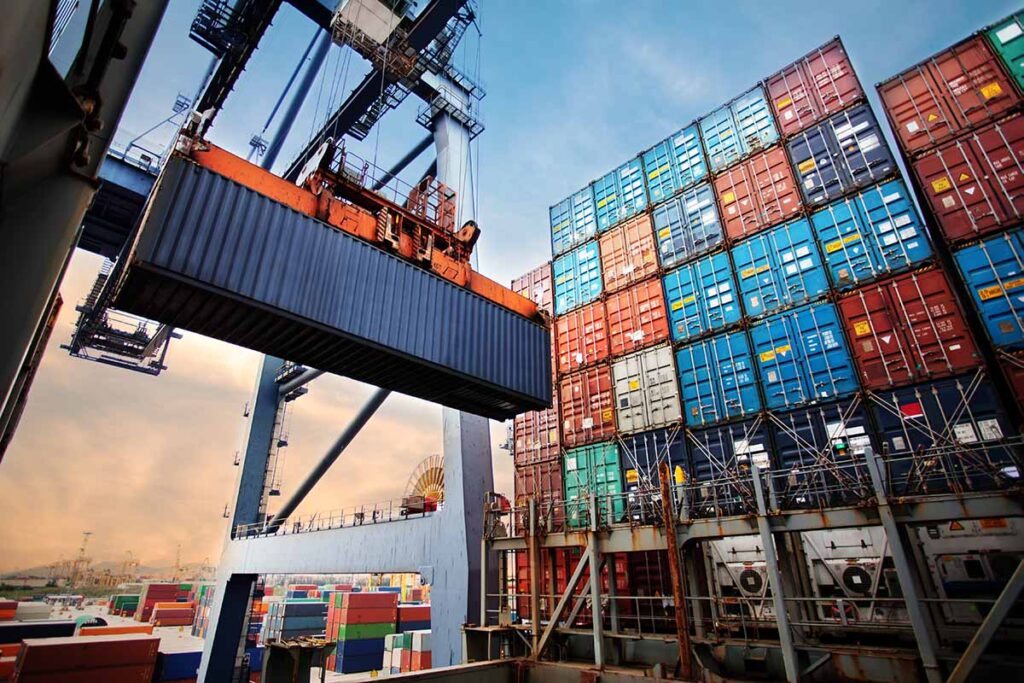Today, Easyimex who help UK, Australian, American and European businesses import products from China, take a look at the spiralling cost of freight prices in what’s fast becoming the shipping crisis of 2021:
When Will Freight Prices Come Down? Should I Keep Importing Containers?
Freight prices from China and the Far East are playing absolute havoc for importers. The cost to ship a 40ft container from China in June 2020 was approximately $2,000 USD, today that container is likely to cost in the region of $15,000 USD!
The reasons for this are, as importers will already know, are of course all COVID related. Where consumers around the world have not spent on hospitality and tourism, they have instead spent more on physical product, especially in the home & garden sectors. – Exports from China have been booming.
Combine all of this with a lack of production in the West, along with goods and raw materials that China and the Far East might otherwise have imported, have not been available. Truck drivers and labour that would have processed empty containers have been in lockdown. All of this has compiled into congestion of containers at all major ports in the west. – Exports from the West to China and the Far East have been hit hard.
In short – there is a fundamental imbalance with the flow of containers around the world, with more containers consistently leaving China & the Far East than are being shipped back! Despite China’s best efforts to produce more shipping containers, this is simply not enough to reverse this global trend with the flow of containers.
Of course, many are also pointing the finger at shipping lines for being ‘greedy’. The fact that the top 11 shipping lines made more money in Q1 2021 than in Q3/Q4 2020 means there is a solid argument to that theory! But for these reasons and more, this is resulting in significant monthly GRI (general rate increase) of freight, and causing a world of pain to businesses that rely on the Far East for their trade and supply of goods.
Just How Bad Is The Problem?
The typical cost to import a 40ft container from China to the UK before the pandemic was approx. $2,500 USD. Today, as of July, that price is now typically $15,000 USD. So this is approximately a $12,500 increase of 500%!
Of course, this is affecting all importers in some way, though some are feeling it more than others. For example, if you’re importing small and high value goods, such as ‘memory cards’ where you might get lets say 100,000 or more units in a container. Then $12,500 USD / 100,000 = 0.12 cent.
However, if you’re importing say assembled bedroom wardrobes or sofas where you only load 50 units per 40ft container. Then $12,500 / 50 = $250 increase per unit! – A lot to pass onto the consumer!
What this means, is there is a global bidding war for shipping. If you’re a sofa importer importing from the Far East, your competition is no longer other sofa importers, as much as it is an importer of memory cards that is prepared to pay more to ship a container than you are!
One by one, importers of lower value product from the Far East start to drop out and simply don’t ship their products, ultimately unable to pass on the price to the consumer.
What Happens Next to Freight Prices?
No one is able to accurately predict exactly how and when the situation will change, and when freight prices will come down. Most industry insiders are only saying ‘freight prices will remain high until the end of the 2021’.
At Easy Imex we know that June/July/August is typically the low season, when freight prices relax. The fact that we saw further spikes in June/July means that the normal ‘rules’ of the low season don’t seem to apply. Furthermore, normally as we get into August/September demand normally rises as importers want stock arriving before Christmas or before Chinese New Year. That’s one fundamental demand that we expect will be normal.
“The higher freight prices go, the more reluctant importers are to ship containers, and so they either don’t ship, or don’t order. This means that the demand that was or still is there for these goods has not been met, meaning as more containers become available, there is even more demand for them! – It becomes an extremely dangerous self perpetuating cycle”
The fact that freight is going ‘up’ in what’s traditionally the time rates normally drop means there will be no time for rates to relax before we hit ‘peak season’ . Combine that with the fact that the fundamental reasons that caused the container shortages in the first place are not about to be fixed anytime soon – I genuinely don’t expect to see any substantial freight decrease until post Chinese New Year 2022.
The truth is, times are challenging but importers will need to make some tough decisions. In many cases, importers need to make the decision of ‘do I stop importing and have no stock to sell? – or do I take a risk and try to pass on large price increases to the consumer?
Many importers have been waiting in hope for freight prices to drop but this currently seems like an ill advised strategy unless you have enough stock to last your business say 12 months.”
– Adam Gilbourne, Managing Director, Easyimex
Some small consolation for importers is that in other reasons aside from freight prices is the world is suffering a large bout of inflation everything from oil, raw materials, property, groceries, even the cost of a haircut, are all going up in price. Meaning, consumers are becoming increasingly aware that we currently live in a time of inflation where things cost more than they used to!
Another consolation for China importers is that COVID has been controlled very well in China, so production remains normal. There are many manufacturing countries such as Malaysia and India where production has been severely affected, or even stopped altogether. What’s more, for certain sectors such as furniture, where Eastern Europe as an example has a solid manufacturing base, they simply do not have the capacity to ‘replace China’ and are suffering both capacity and raw material price issues themselves.
In short, while shipping goods from China is extremely expensive, you also have to ask ‘what’s the alternative?’
What Can I Do As an Importer?
In truth, there is no quick fix or simple answer to counter this global ‘unprecedented’ rise in freight costs. However, here are a few suggestions & solutions that we have been working with our clients at Easy Imex.
- Decide your strategy – as above, we don’t expect freight prices to be anything like ‘normal’ on this basis ask yourself – ‘can I afford NOT to ship?’
- Easy Imex has managed to successfully negotiate various contract rates with our freight partners, providing various levels of shelter from GRI (general rate increase).
- Source new suppliers – many businesses have contacted us to bypass the wholesaler or importer they are currently buying from, to start importing their product directly from China. We have also had a large number of enquiries from businesses that simply want to keep importing from China, but are willing to change manufacturers to improve their costs.
If you’re looking to scale your business, bring a new product to market, or if your current manufactures are letting you down, feel free to contact the Easy Imex team for a no obligation consultation via email, or phone on (UK) 0203 8077 225, AUS (02) 8880 5876, NL (20) 369 9878 or CN +86 021 5422 0593.





13 Responses
import costs up by £10,000 a container, ebay charging approx 25% in fees, a recipe for disaster for hundreds of sellers..
start manufacturing in your own country? goods from China once cheap no longer are. This is a good opportunity to return to manufacturing and produce locally and reduce carbon foot print
Amj,
Having seen 2 comments of yours about it, I’ve got to say that 25% is not the typical sales fee for most ebay sellers. I’m paying about half that, including the shop subscription and PL fees.
The listed FVFs for UK businesses using managed payments vary, but most are somewhere between 6.9% and 12.9%. 12.9% seems to be the top level, though most are around the 10% or 11% mark.
To get to 25%, you’d have to be blowing a wodge on PL, having a shop subscription beyond your realistic sales level, or using a lot of the upgrades. If your selling costs chart says 25%, you need to check where it’s going and why and ask yourself is it necessary. Unless there is a secret 25% fee category that ebay don’t list, there’s no need to spend that much.
I’m surprised the Chinese government hasn’t stepped in, as the factories of the bigger items must be getting hit hard. Can’t be good for their economy and it should be a solveable problem. Need containers? Take the empties back. If the milkman can manage it…
Thanks Gav
our FVF seem to be around 17%, not sure why it’s so high, will see if i can get an answer form eBay
@amj and @Gav
The issue for us and many others is as follows. If your products are in a category thats been flooded with idiots jumping on the bandwagon and then unless you give Ebay 10 to 11% PL fee your adverts are hidden for 90% of the time and hence dont sell period. So all in all Ebay are getting approx 24% in the lines we sell in.
All in all been selling on Ebay since 2009 and we have seen profits gone from 20K a year to selling at a loss
@amj our FVF are 16.5% but what I can’t work out is if this includes EMP or not. Trying to work out eBay invoices now and VAT computations is a nightmare.
Derek Duval , Spot on..
Selling and making a profit on ebay is getting harder by the day..
as chinese sellers still exist and as above, fees are up..
Guys, regarding fee levels, there’s Chinese sellers in every category I sell in too, sending direct via hong kong post or using fulfillment houses in the UK. There is also industrial scale duplication by some sellers, turning a handful of products into 1000s of listings and crowding out the listings. Then there is the dropshippers. Overall, a pretty crowded place to sell. But I’ve still set the PL fees really low, way below the ebay suggestions and they still seem to work, for me anyway. Maybe it’s worse in your categories, but that doesn’t mean it’s typical.
Overall, I’m not bothered about ebay fees. Import costs, that is definitely a bother. The sooner they go down or stablise, the better.
@Jonty, ours are similar and similarly struggling to work out exactkly how eBay have calculated them (as pinted out above, they shouldn’t be over 12%)
Don’t forget fees are not just 12%, there’s a 30p + VAT fixed fee on every sale too. I sold a £4.99 item the other day in a 12.9% category and the fees including VAT were £1.23, which is outrageous on a low value item.
If you sell fairly low value items, the 30p makes a massive difference to your overall percentage. I do, and according to eBay my selling costs are also around 24%
On PayPal Micropayments I was paying FAR less.
JoeB, ah i see.. makes more sense now..
But the West will need them to convert to Housing for all the immigrate coming north…..